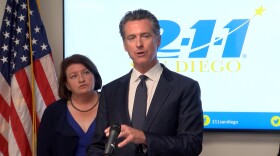
Thomas Fudge
Science and Technology ReporterA journalist with 30 years of experience, Tom covers science and technology stories for KPBS' platforms. He joined KPBS in 1998 to cover San Diego issues related to growth, transportation, and development. He previously served as host of These Days (now KPBS Midday Edition) and as a news editor. Tom began his broadcasting career in 1988 at WSUI Radio in Iowa City as a reporter and newscaster. He then spent five years at Minnesota Public Radio (MPR) where he worked as a reporter. Following his departure from MPR, Tom was a freelance journalist, working for Twin Cities Public Television, WCCO Radio, and a variety of regional and national newspapers and magazines. He has received recognition for his outstanding work in hosting and public affairs reporting from the Unity Awards, the Northwest Broadcast News Association, and the San Diego chapter of the Society of Professional Journalists.
-
The campground at Tijuana River Regional Park is set to reopen Tuesday. The union for park rangers says pollution levels in the area make it unsafe for rangers and visitors.
-
Entomologist at UC San Diego says dung beetles serve the environment and show a great talent adapting to it.
-
The City of San Diego invited young people from its federally designated Promise Zone — from Barrio Logan to Encanto — to sample jobs and training programs.
-
The annual Kyoto Prize winners came to San Diego for this year’s symposium. Kyoto Laureate John Pendry talked about the theory of bending light rays that’s led to technologies that do that and more.
-
Cuts to the National Oceanic and Atmospheric Administration affect research and sea monitoring partnerships between NOAA and Scripps Institution of Oceanography.
-
A San Diego assemblyman introduced a bill to outlaw discriminatory pricing that’s based on how you purchase items online and what merchants think you’re willing to pay.
-
For the first time, United Nations members have agreed on a unified treaty to protect biodiversity in the high seas.
-
Gov. Gavin Newsom threw his support behind San Diego's Measure D Thursday.
-
Construction began Thursday near Poway on the first leg of a 10,000-mile-long broadband network.
- In Escondido, a school board member changes her name but not her politics
- SCUBA divers volunteer at San Diego's Birch Aquarium
- San Diego Unified is getting rid of some K-8 middle schools
- San Diego City Council to once again consider Balboa Park parking fees
- Elected officials announce proposed ordinance aimed at fed enforcement actions













